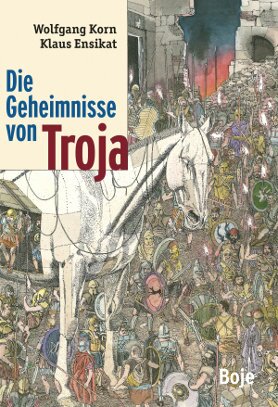Wolfgang KornKlaus Ensikat
Die Geheimnisse von Troja
[The secrets of Troy]
- Boje Verlag in der Bastei Lübbe GmbH & Co. KG
- Cologne 2013
- ISBN 978-3-414-82340-3
- 184 Pages
- 11 Suitable for age 12 and above
- Publisher’s contact details
Wolfgang Korn
Die Geheimnisse von Troja
[The secrets of Troy]
This book was showcased during the special focus on Russian (2012 - 2014).
Sample translations
Review
It’s high time for this book: Wolfgang Korn’s Die Geheimnisse von Troja [The secrets of Troy], illustrated by the incomparable Klaus Ensikat. Gathering dust on the library shelf, on the other hand, is the book of our childhood treasures, Mythology: Timeless Tales of Gods and Heroes [Edith Hamilton], with its brown imitation leather binding. While these stories gather dust, their protagonists and arenas are still quite current—as shadows of mythical heroes and landscapes that were once very real for us as world explorers.
King Arthur in Germanic forests and, in somewhat warmer fantasy climes, Odysseus, Achilles, the treasure of Priam, the walls of Troy, the Trojan War, the legendary wooden horse, and this absolutely confounding clan of gods and demigods related by blood and marriage, with its extremely capricious passions. They have lost their shine and no longer relate to our everyday lives. Yet they eerily persist as a stubborn cliché. A life long. Why? Because these characters in the back rooms of our memories are momentarily brought back to life, again and again. Here a The Knights of the Round Table, and there a report on archaeological excavator Heinrich Schliemann, who has been stylized into the discoverer of Troy. Here anniversary reports in newspapers and on radio and television, and there maybe an epic film on Troy starring Brad Pitt. And so on and so forth. Thus over time these mythological heroes not only wither into icons of a diffuse world beyond everyday life, but also become petrified into eternal statues, no matter how true or false their foundations.
None of that is true—except for the fickleness of the gods. We sugarcoat our memories of the stories in order to maintain our simple worldview of just heroism, battles and courage, good and evil, Orient and Occident. For just this reason, Wolfgang Korn’s book is so important. It demystifies in a friendly but radical fashion everything we thought we knew about the Battle of Troy and Homer’s heroes from the Iliad and the Odyssey. But when you finish reading you are left feeling neither empty nor disillusioned. With its wonderful narrative following the course of history, the book offers insight that is anything but disillusioning. Getting to know the historical truth is discerning, complex, and fantastically multifaceted—in the precise sense of having many planes—and at the same time it can be so exciting!
Wolfgang Korn takes on the role of a journalist who writes seven blog chapters, reporting on a study tour to the excavation sites on and around the Hisarlik tell (“hill or mound”) at the interface between the Aegean and the Bosporus, at the northwesternmost corner of Turkey. Classical scholars since time immemorial have presumed that there within the landscape of Troas is the site that Homer described in the eighth century BCE in the Iliad and the Odyssey (Korn distinguishes between the mythical city and the real excavation site at Troy).
The explorer Wolfgang Korn is not an expert, but an educated and inquisitive layperson. His constant companion is Klaus Ensikat, a documentary illustrator whom you could almost call a “photographer.” Korn becomes an observer of the actual excavations; he talks with journalist colleagues, with antiquaries and other scientists, and also with local inhabitants, thereby delving ever deeper into the stories and history of Troy. The explorer becomes a time traveler, going back to the third millennium BCE, that is, to the site where Troy’s first settlement level is presumed to have been. Korn travels clear across millennia and through the different settlement levels of the area—forty-six construction phases in nine main levels!—of which Troy levels VI and VIIa (ca. 1700–1200 BCE) are considered the most probable candidate for Homer’s Troy.
Korn’s travelogue on Troy is extremely nuanced and yet at the same time easy to grasp and written in an entertaining style, so that readers find themselves caught up in a historical mystery novel whose ending has yet to be written. Alone the discussion among luminaries in history and archeology (for example between the Tübingen professors Manfred Korfmann and Frank Kolb) is amazing and will make your hair stand on end. No matter whether you consider Troy to be a mainstay bridging the Occident and the Orient—as did Korfmann, who died in 2005—or as the cradle of Occidental civilization, what seems to be the most significant question at the end of the book remains as unanswered as the final secrets of Troy. The explorer and his friend Hermann trek together one more time over the hills of this wonderfully peaceful seaside landscape, asking themselves “How many wars and crises can we afford to go through before one day finally accepting a lasting Trojan peace or ...?” At that moment the sun sets into the sea like a burning ball of gold, silencing the two travelers. What a wonderful open ending!

King Arthur in Germanic forests and, in somewhat warmer fantasy climes, Odysseus, Achilles, the treasure of Priam, the walls of Troy, the Trojan War, the legendary wooden horse, and this absolutely confounding clan of gods and demigods related by blood and marriage, with its extremely capricious passions. They have lost their shine and no longer relate to our everyday lives. Yet they eerily persist as a stubborn cliché. A life long. Why? Because these characters in the back rooms of our memories are momentarily brought back to life, again and again. Here a The Knights of the Round Table, and there a report on archaeological excavator Heinrich Schliemann, who has been stylized into the discoverer of Troy. Here anniversary reports in newspapers and on radio and television, and there maybe an epic film on Troy starring Brad Pitt. And so on and so forth. Thus over time these mythological heroes not only wither into icons of a diffuse world beyond everyday life, but also become petrified into eternal statues, no matter how true or false their foundations.
None of that is true—except for the fickleness of the gods. We sugarcoat our memories of the stories in order to maintain our simple worldview of just heroism, battles and courage, good and evil, Orient and Occident. For just this reason, Wolfgang Korn’s book is so important. It demystifies in a friendly but radical fashion everything we thought we knew about the Battle of Troy and Homer’s heroes from the Iliad and the Odyssey. But when you finish reading you are left feeling neither empty nor disillusioned. With its wonderful narrative following the course of history, the book offers insight that is anything but disillusioning. Getting to know the historical truth is discerning, complex, and fantastically multifaceted—in the precise sense of having many planes—and at the same time it can be so exciting!
Wolfgang Korn takes on the role of a journalist who writes seven blog chapters, reporting on a study tour to the excavation sites on and around the Hisarlik tell (“hill or mound”) at the interface between the Aegean and the Bosporus, at the northwesternmost corner of Turkey. Classical scholars since time immemorial have presumed that there within the landscape of Troas is the site that Homer described in the eighth century BCE in the Iliad and the Odyssey (Korn distinguishes between the mythical city and the real excavation site at Troy).
The explorer Wolfgang Korn is not an expert, but an educated and inquisitive layperson. His constant companion is Klaus Ensikat, a documentary illustrator whom you could almost call a “photographer.” Korn becomes an observer of the actual excavations; he talks with journalist colleagues, with antiquaries and other scientists, and also with local inhabitants, thereby delving ever deeper into the stories and history of Troy. The explorer becomes a time traveler, going back to the third millennium BCE, that is, to the site where Troy’s first settlement level is presumed to have been. Korn travels clear across millennia and through the different settlement levels of the area—forty-six construction phases in nine main levels!—of which Troy levels VI and VIIa (ca. 1700–1200 BCE) are considered the most probable candidate for Homer’s Troy.
Korn’s travelogue on Troy is extremely nuanced and yet at the same time easy to grasp and written in an entertaining style, so that readers find themselves caught up in a historical mystery novel whose ending has yet to be written. Alone the discussion among luminaries in history and archeology (for example between the Tübingen professors Manfred Korfmann and Frank Kolb) is amazing and will make your hair stand on end. No matter whether you consider Troy to be a mainstay bridging the Occident and the Orient—as did Korfmann, who died in 2005—or as the cradle of Occidental civilization, what seems to be the most significant question at the end of the book remains as unanswered as the final secrets of Troy. The explorer and his friend Hermann trek together one more time over the hills of this wonderfully peaceful seaside landscape, asking themselves “How many wars and crises can we afford to go through before one day finally accepting a lasting Trojan peace or ...?” At that moment the sun sets into the sea like a burning ball of gold, silencing the two travelers. What a wonderful open ending!
Translated by Allison Brown

By Siggi Seuß
Siggi Seuß, freelance journalist, radio script writer and translator, has been writing reviews of books for children and young people for many years.
